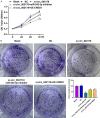CircRNA_002178 as a ceRNA promotes the development of colorectal cancer by regulating miR-542-3p/CREB1
- PMID: 34650680
- PMCID: PMC8507087
CircRNA_002178 as a ceRNA promotes the development of colorectal cancer by regulating miR-542-3p/CREB1
Abstract
Objective: Colorectal cancer (CRC) is a malignant tumor commonly found in the digestive tract. This study aimed to explore the effect of circRNA_002178 as a competing endogenous RNA in the development of CRC by regulating the miR-542-3p/cAMP response element binding protein 1 (CREB1) axis and its molecular mechanism.
Methods: The relative expressions of circ_002178, miR-542-3p, and CREB1 in patients' cell lines and CRC tissues were measured using Western blot and qRT-PCR. The localization and expression of circ_002178 were determined using fluorescence in situ hybridization and nucleocytoplasmic separation tests. The targeting relationships among circ_002178, miR-542-3p, and CREB1 were validated using RNA immunoprecipitation and dual luciferase reporter assays. The cells' proliferation, invasion, and colony forming ability were tested using CCK8, Transwell, and Clone formation assays, respectively. The cellular glucose consumption, lactification, and adenosine triphosphate (ATP) production were measured using glucose uptake colorimetric assay kits, lactate colorimetric assay kits and ATP assay kits, respectively.
Results: The circ_002178 and CREB1 expressions were up-regulated in the CRC cells and tissues, and the miR-542-3p expression was down-regulated (all P<0.05). The circ_002178 knockdown inhibited the proliferation, invasion, colony formation, and glycolysis of the CRC cells in vitro, but the overexpression of circ_002178 induced the opposite result (both P<0.05). Our molecular mechanism study revealed that circ_002178, as the molecular sponge of miR-542-3p, promotes CREB1 expression. The downregulation of miR-542-3p or the overexpression of CREB1 is able to partly weaken the inhibition of CRC cells through the circ_002178 knockdown.
Conclusion: circ_002178 promotes the invasion, proliferation, colony formation, and glycolysis of CRC cells by regulating the miR-542-3p/CREB1 axis, thus driving the development of CRC.
Keywords: Colorectal cancer; cAMP response element binding protein 1; circ_002178; glycolysis; miR-542-3p.
AJTR Copyright © 2021.
Conflict of interest statement
None.
Figures









Similar articles
-
circ_0136666 Facilitates the Progression of Colorectal Cancer via miR-383/CREB1 Axis.Cancer Manag Res. 2020 Aug 4;12:6795-6806. doi: 10.2147/CMAR.S251952. eCollection 2020. Cancer Manag Res. 2020. PMID: 32821160 Free PMC article.
-
Hsa_circ_0001535 Regulates Colorectal Cancer Progression via the miR-433-3p/RBPJ Axis.Biochem Genet. 2023 Jun;61(3):861-878. doi: 10.1007/s10528-022-10287-4. Epub 2022 Oct 8. Biochem Genet. 2023. PMID: 36208372
-
Circ-MFN2 Positively Regulates the Proliferation, Metastasis, and Radioresistance of Colorectal Cancer by Regulating the miR-574-3p/IGF1R Signaling Axis.Front Genet. 2021 May 19;12:671337. doi: 10.3389/fgene.2021.671337. eCollection 2021. Front Genet. 2021. PMID: 34093664 Free PMC article.
-
CircRNA_0084927 promotes colorectal cancer progression by regulating miRNA-20b-3p/glutathione S-transferase mu 5 axis.World J Gastroenterol. 2021 Sep 28;27(36):6064-6078. doi: 10.3748/wjg.v27.i36.6064. World J Gastroenterol. 2021. PMID: 34629820 Free PMC article.
-
Homo Sapiens Circular RNA 0079993 (hsa_circ_0079993) of the POLR2J4 Gene Acts as an Oncogene in Colorectal Cancer Through the microRNA-203a-3p.1 and CREB1 Axis.Med Sci Monit. 2019 Sep 13;25:6872-6883. doi: 10.12659/MSM.916064. Med Sci Monit. 2019. PMID: 31515467 Free PMC article.
Cited by
-
Circ_0000370 Plays an Oncogenic Role in Colorectal Cancer by Regulating the miR-502-5p/SIRT1 Axis.Biochem Genet. 2024 Apr;62(2):1231-1247. doi: 10.1007/s10528-023-10468-9. Epub 2023 Aug 10. Biochem Genet. 2024. PMID: 37561331
-
Circular RNAs as Diagnostic and Prognostic Indicators of Colorectal Cancer: A Pooled Analysis of Individual Studies.Pathol Oncol Res. 2022 Mar 17;28:1610037. doi: 10.3389/pore.2022.1610037. eCollection 2022. Pathol Oncol Res. 2022. PMID: 35369570 Free PMC article.
-
Integrated analysis of the functions and clinical implications of exosome circRNAs in colorectal cancer.Front Immunol. 2022 Jul 18;13:919014. doi: 10.3389/fimmu.2022.919014. eCollection 2022. Front Immunol. 2022. PMID: 35924235 Free PMC article.
-
High Expression of circ_0001821 Promoted Colorectal Cancer Progression Through miR-600/ISOC1 Axis.Biochem Genet. 2023 Feb;61(1):410-427. doi: 10.1007/s10528-022-10262-z. Epub 2022 Aug 9. Biochem Genet. 2023. PMID: 35943670 Free PMC article.
References
-
- Chen PH, Wu YY, Lee CH, Chung CH, Chen YG, Huang TC, Yeh RH, Chang PY, Dai MS, Lai SW, Ho CL, Chen JH, Chen YC, Hu JM, Yang SS, Chien WC. Uracil-tegafur vs fluorouracil as postoperative adjuvant chemotherapy in stage II and III colon cancer: a nationwide cohort study and meta-analysis. Medicine (Baltimore) 2021;100:e25756. - PMC - PubMed
-
- Silveira MJ, Castro F, Oliveira MJ, Sarmento B. Immunomodulatory nanomedicine for colorectal cancer treatment: a landscape to be explored? Biomater Sci. 2021;9:3228–3243. - PubMed
LinkOut - more resources
Full Text Sources
Research Materials
